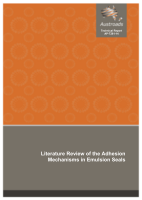Pavement

- Publication no: AP-T261-14
- ISBN: 978-1-925037-52-4
- Published: 20 February 2014
- PDF (free) Download
There has been renewed interest in emulsion seals in Australia, but an impediment to their widespread adoption has been perceived as adhesion problems. This study looks at adhesion test procedures and means of improving emulsion seal performance. Three key mechanisms are initial adhesion, development of cohesive binder strength (green strength), and resistance to stripping in the presence of water. Initial adhesion and resistance to stripping can be evaluated for emulsion binders using tests developed for neat bitumen. Green strength can be measured by a number of international tests which could be adopted for routine Australian use. Improvements in materials and construction practices may have reduced the likelihood of green strength failure. Arrangement of a series of road trials utilising international and local expertise could be considered to test this presumption.
- 1. Introduction
- 1.1. Aims
- 1.2. Adhesion in Emulsion Seals
- 2. Emulsion Overview
- 2.1. Emulsion Properties
- 2.2. Types of Emulsion
- 3. Emulsion Adhesion Mechanisms
- 3.1. Breaking and Curing
- 3.2. Initial Adhesion
- 3.3. Green Strength
- 3.4. Resistance to Stripping
- 4. Test Methods Covering Adhesion, Stripping and Seal Strength
- 4.1. General
- 4.2. Australian Methods
- 4.3. International Methods
- 4.4. Classification of Test Methods
- 4.4.1. Initial Adhesion
- 4.4.2. Green Strength
- 4.4.3. Resistance to Stripping
- 4.4.4. Field Tests
- 4.4.5. Others
- 5. Discussion
- 5.1. General
- 5.2. Green Strength Testing
- 5.3. Development of Predictive Model
- 5.4. Testing of Improved Materials and Practices
- 6. Conclusions
- References
